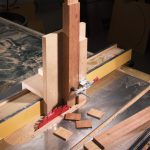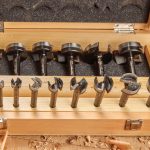We may receive a commission when you use our affiliate links. However, this does not impact our recommendations.
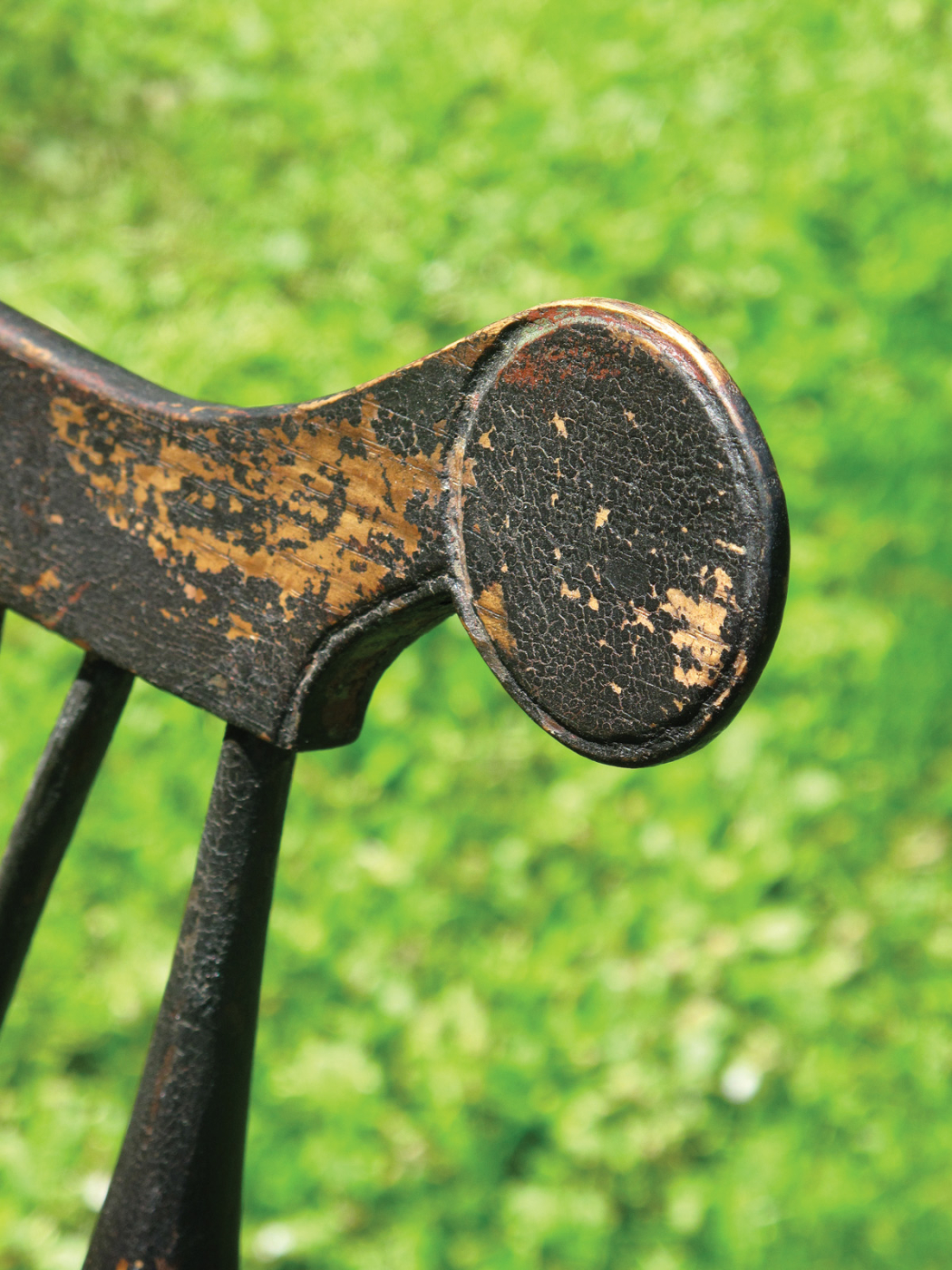
Authentic but fake. A friend of Michael Dunbar’s transported this chair for him and the tarp came off in a rainstorm. The result was this wear. When Mike saw the piece he wasn’t mad at all. “It looks better now!” he said.
Fictional ‘incidents’ give a piece a believable back story.
In Part 1 I gave an overview of creating an aged look for new pieces of furniture, and discussed mechanical wear.
The second prevalent type of wear is incidental. “Incidental” means wear that did not result from ordinary use. Incidental wear is what happens to a piece of furniture when it spends time around human beings. Incidental wear might happen while the piece is experiencing ordinary use. However, it is not the result of that use. It is caused by something else. In writing your plausible fiction for a piece you made, ordinary wear is the day-to-day stuff of life. Incidental wear is the events that make life interesting.
Below are a bunch of twists and turns you can include in the plot of the story you are telling as you artificially age a piece of furniture.
Your Young Vandals
Furniture always endures children. Generation after generation, they are a constant. Children use furniture, but not always in the same way as adults. They abuse furniture. It is part of growing up. Wear records a piece of furniture’s encounters with each child it has lived with.
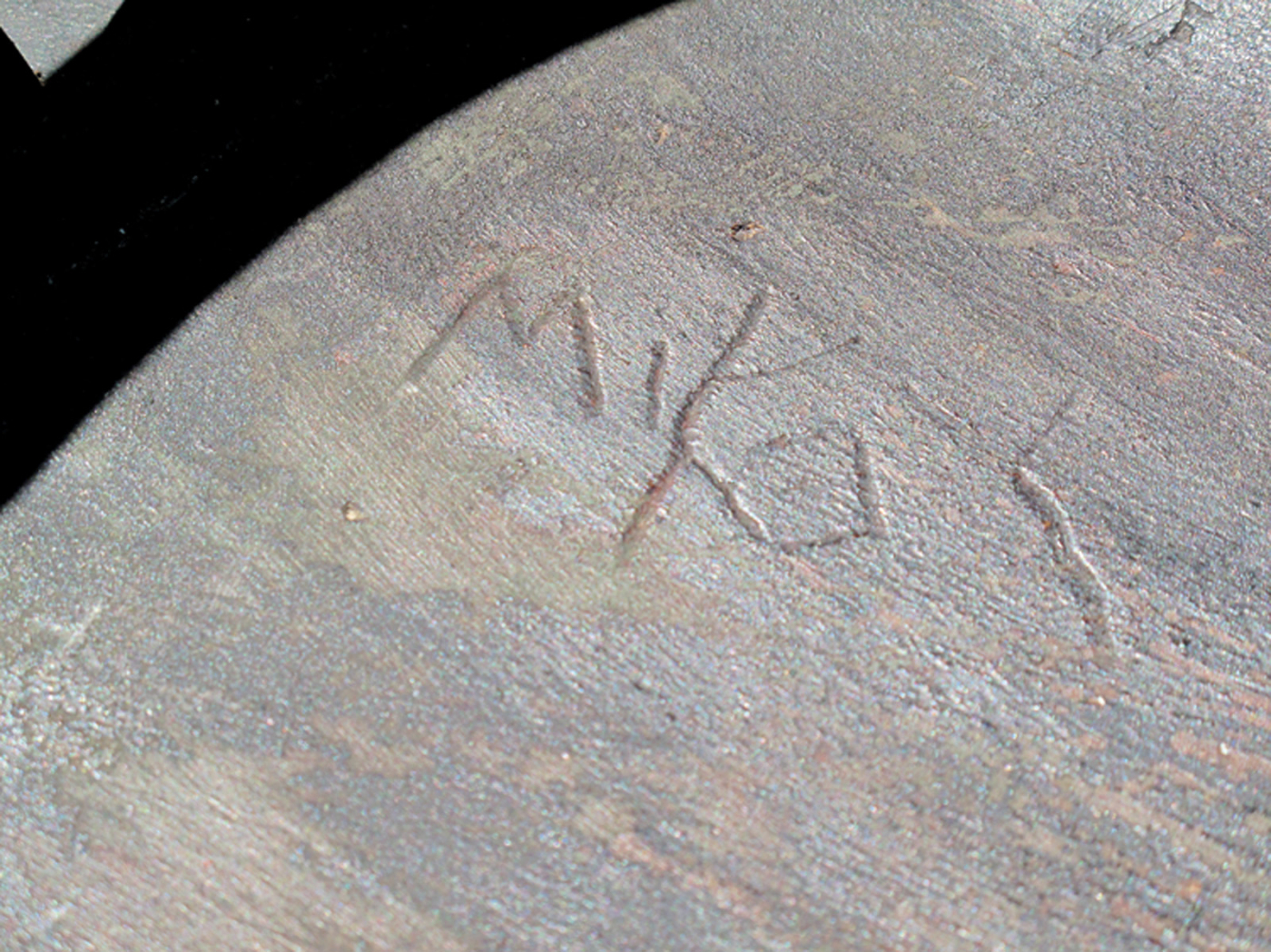
Mikey was here. When Michael Dunbar went to add some “incidental” wear to the seat of this chair, he carved his name in the seat.
Let’s face it: No matter how much we love our kids, they’re little vandals. They stand on things. They break things. They bang things. They pick at things. They drag things. All these activities create distinct wear patterns. When I was young every boy carried a pocketknife. When I was not using mine to play “splits” or “mumbletypeg,” I was always looking for something to carve or cut my initials into. While I don’t remember defacing my mother’s furniture, I have seen lots of antique furniture that has suffered at the hands of a bored youngster. Sometimes the vandalism is obvious and carved into a visible surface. However, fearing a parent’s wrath, kids often carved in less obvious places. Initials were a popular motif to leave behind.
Your Wooden Chew Toys
While families do not generally have as many pets as children, pets can be equally destructive. Dogs chew; cats claw. Dogs are lazy and tend to chew while lying down. Cats invest more effort in creating damage. They can stand up when they sharpen their claws. Keep these thoughts in mind when simulating pet-induced wear.
I once made a large Windsor easy chair just for myself. A short while after I completed it I came into the room to find a puppy with her head resting on a side stretcher while she teethed on the center stretcher. She looked up at me casually as if nothing were wrong, and went on chewing. Her needle-point puppy teeth covered the stretcher with tiny holes. Needless to say, I wasn’t happy. However, she grew up to be that one special dog that each of us is awarded in life. She’s been gone now more than a decade and those tooth marks now mean the world to me.
Rats and mice are not usually kept as pets, but they do leave their evidence on old furniture. Cupboards and other pieces that contain food attract rodents. The most common damage is a small gnawed hole, often between the lower corner of a door and a stile. The reason they usually enter here is the rodent only had to enlarge a preexisting opening. They will also chew their way into a drawer – front or back, whichever is easier. Once inside a piece of furniture, they get what they are after and seldom do any more damage.
‘Improvements’ to the Piece
During the 18th and 19th centuries all sorts of labor-saving devices were developed. These included sewing birds, yarn swifts, meat grinders and apple peelers. Using these devices required they be secured to a handy surface. Furniture, especially tabletops, was always a likely place. These items relied on a clamp with a lower thumbscrew that was tightened into the bottom of the table leaf. The screw always left marks on the bottom of the leaf, although the clamp itself caused less damage on the top. These marks are usually in a row, a set distance back from the leaf’s edge. If the table was in a kitchen or a work area, the marks of several different devices could be clustered in their own separate rows.
Sometimes devices such as a small vise or a pencil sharpener were permanently attached to a top. This was more likely to happen to a piece of furniture after it had been relegated to the workshop or barn. In this case, you will generally find screw or nail holes, often in the upper surface. The outline of a backplate may also remain on the tabletop.
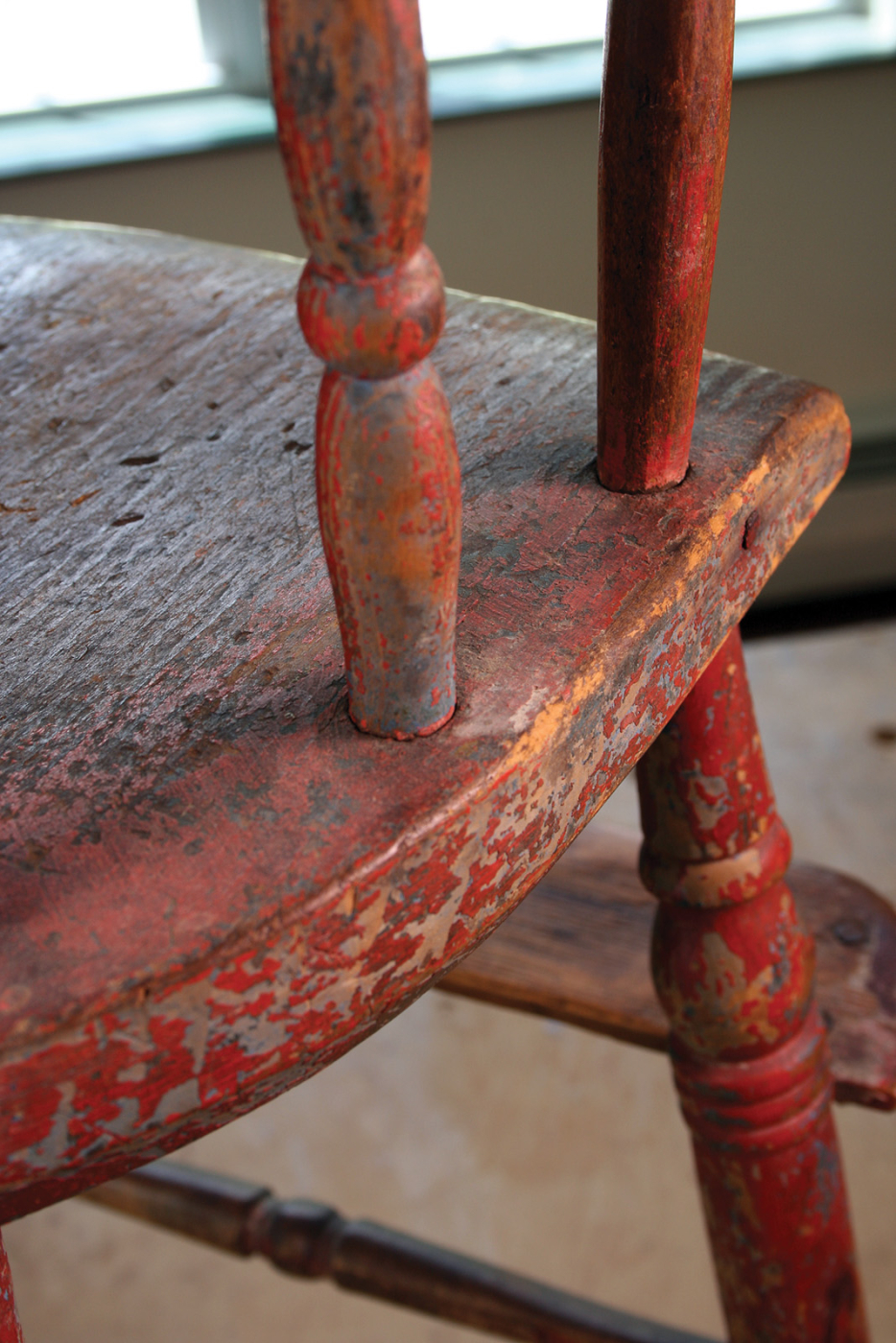
Worn away. This highchair is missing a lot of its finish. One can only imagine that frequent cleaning after a messy child had something to do with it.
Worn Clean Off
The act of cleaning furniture is often more gentle than normal use, but cleaning will eventually leave its evidence in the form of wear. Like normal use, the wear caused by cleaning is usually predicable. After all, every housekeeper did the same things while caring for furniture.
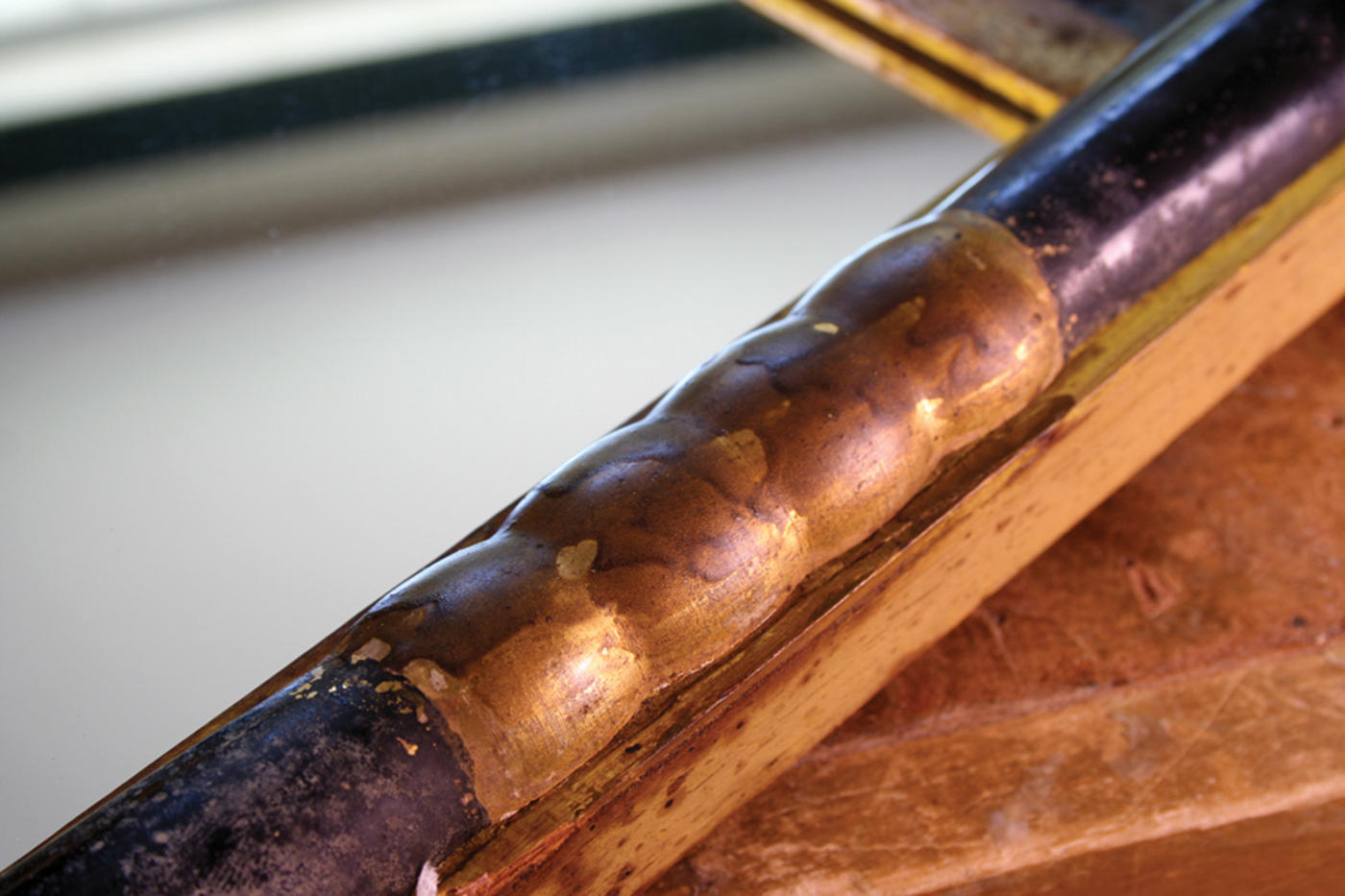
Overfed. This detail on a mirror has been coated with finish many times by an over-aggressive housekeeper.
Wiping a tabletop after preparing or eating a meal is the most frequent activity; a tabletop will be wiped several times a day. While water and a cloth are pretty gentle, they will eventually wear through even the toughest finish. Wood exposed to a wet cleaning cloth and air will fade.
Unless refinished, a century of wiping will eventually remove almost all the finish from a tabletop. Without a finish to protect the wood, housewives would wash the top with harsh, abrasive cleaners such as lye, bleach or pumice to sanitize it and to remove food stains. These products bleached the wood, turning it the color of old bone. Antique collectors call this a “scrubbed top,” and a real one is highly prized. Of course scrubbing the top with abrasives also rounds edges and corners. So, you will not find a scrubbed top with crisp edges.
Another furniture-care process had the opposite effect of wiping and cleaning. When I began making furniture 38 years ago, my grandmother told me how important it was to “feed the finish.” As most woodworkers know, this is an old wives’ tale. The thought was that finishes dried out and needed to be rejuvenated. The most common method was to wipe the furniture with boiled linseed oil thinned with turpentine. The result was a new layer of finish that made the piece temporarily shiny. Doing this every several years caused the oil to eventually build up. The linseed oil also darkened, leaving a piece that was fed regularly with a dark skin, thick enough to fill shallow details and recessed corners.
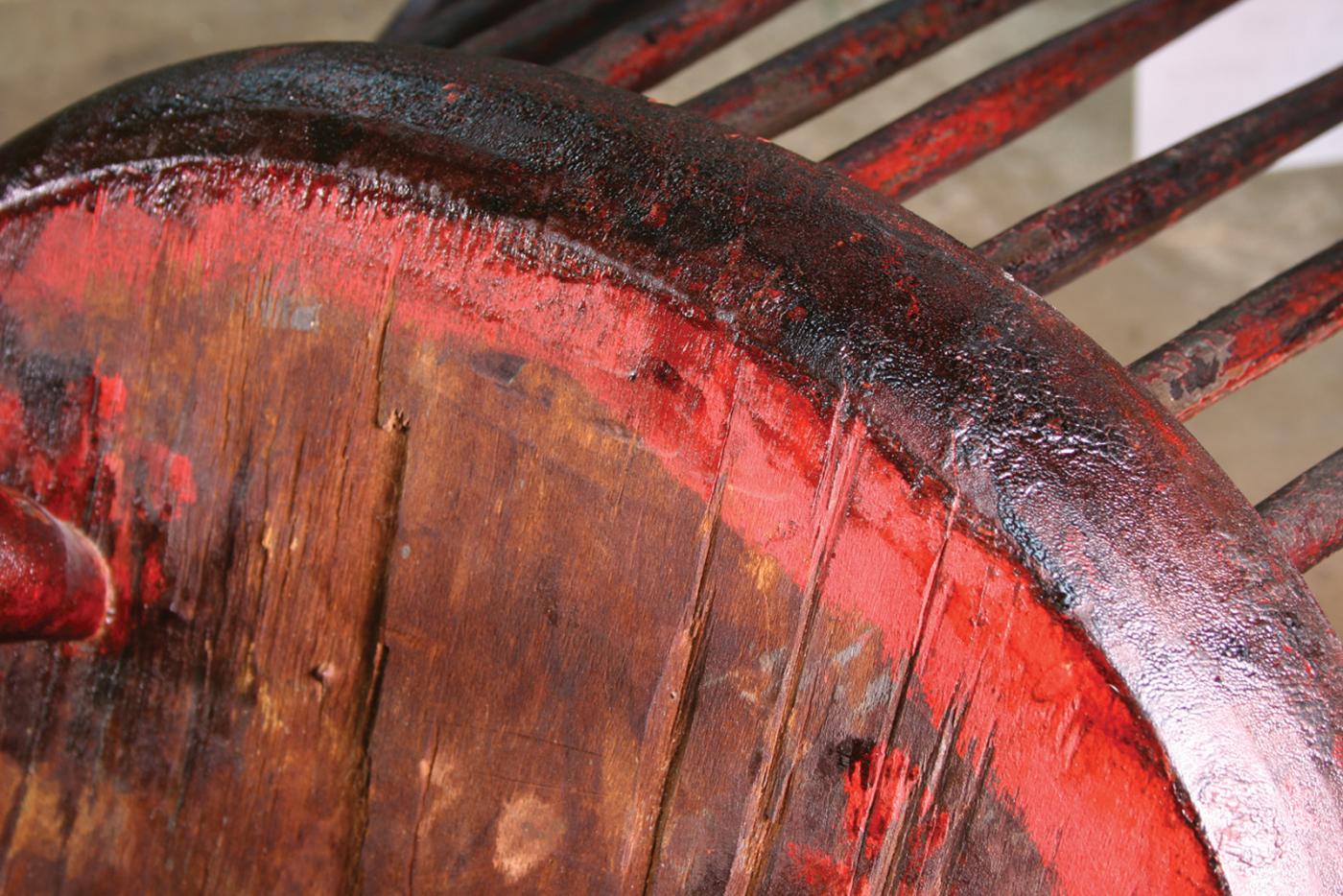
A quart too much. This chair has been “fed” too much linseed oil over the years, hence its gummy surface finish.
A lot of furniture, especially formal pieces with drawers, have brass pulls and lock escutcheons. Brass dulls and on a regular basis over the centuries, good housekeepers polished them. Polishing brasses will wear the metal and soften its details. The process also wears away the finish around the brass, exposing raw wood.
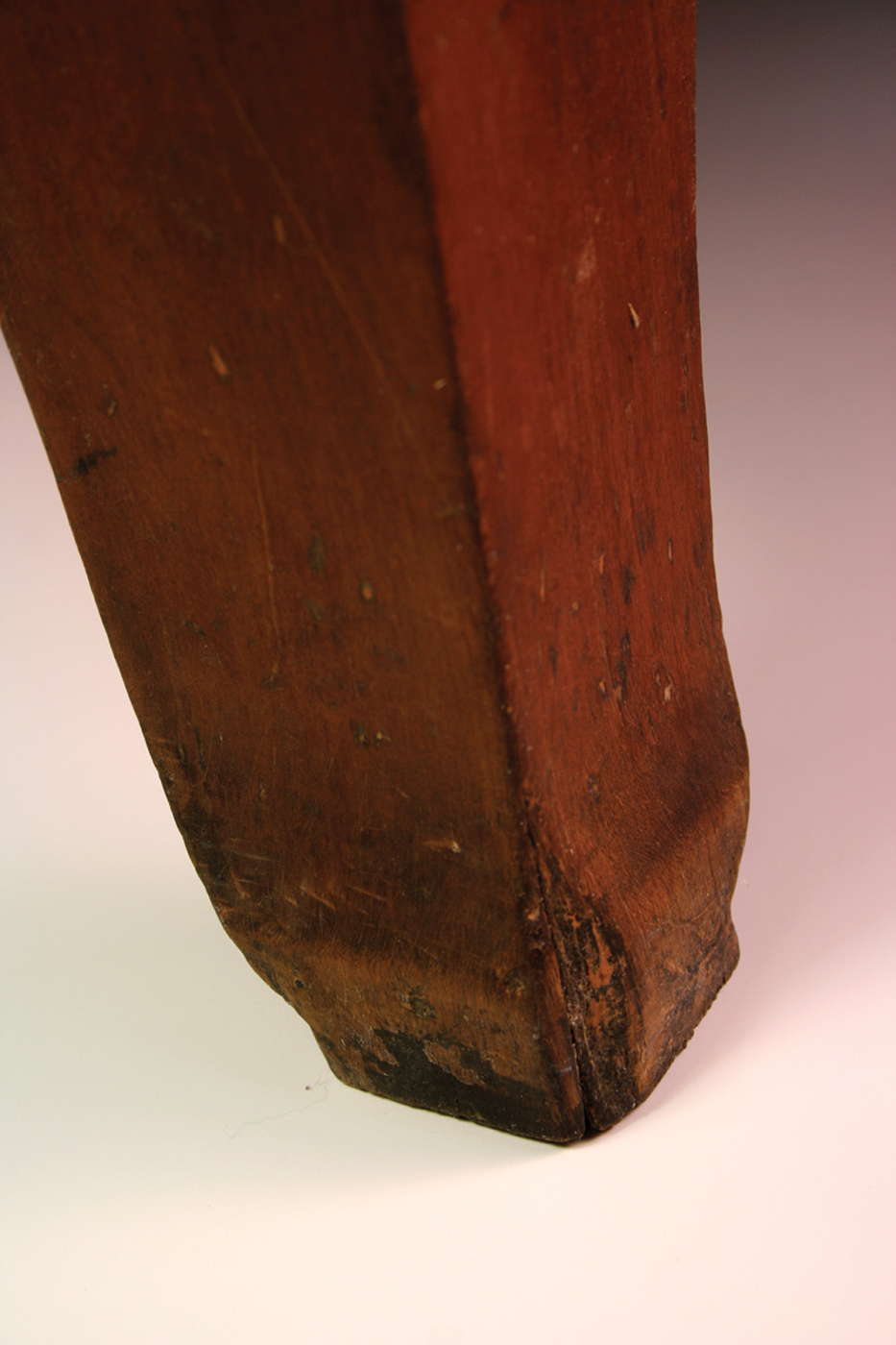
Whack-a-foot. The leg of this dresser has seen its share of brooms, vacuum cleaners and feet.
Any piece of furniture that sits on the floor is regularly assaulted by brooms, mops and vacuum cleaners. These tools bang up the finish and eventually wear away the wood. Add the kicking of shoes to the bumping, banging cleaning instruments and any old piece of furniture will show wear for a height of an inch or two above the floor.
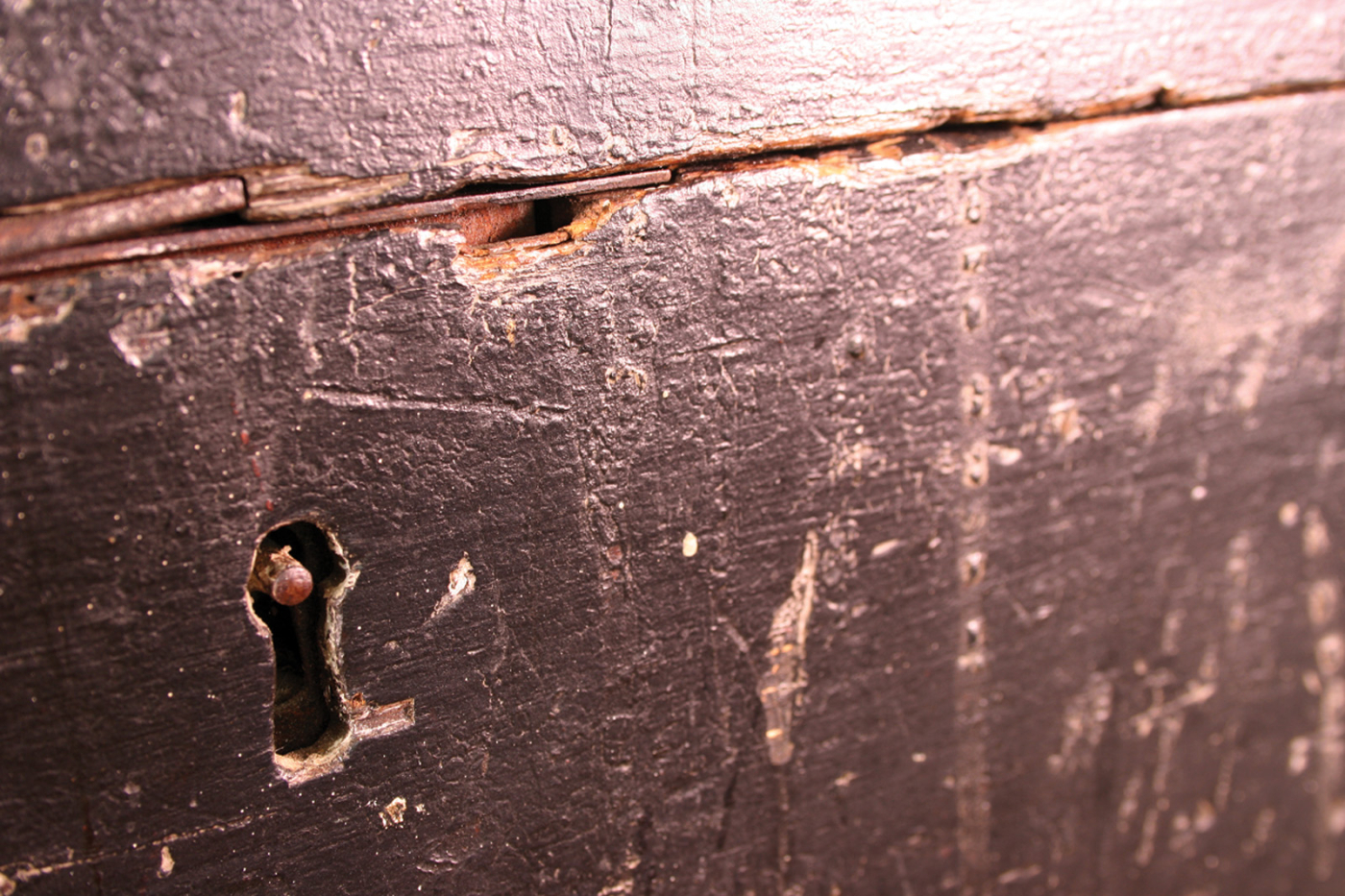
No key? No problem. This chest was pried open with a screwdriver at some time during its life – a common form of damage.
Breaking & Entering
We all know that wood moves. It swells when it’s humid and it shrinks when it’s dry. As a result, drawers and doors often stick in the summer, requiring they be pried open, usually with a metal tool such as a screwdriver. It is hard to do this without creating some damage. Repeated year after year, the wear caused by prying can become substantial.
Stains, Smears, Splatters & Burns
Liquids get spilled on furniture. It would be impossible to list all the ways this can happen, but some ways happen more regularly than others. Water rings occur when a wet object is placed on a wooden surface. The ring can be only in the finish, or it can penetrate into the wood. A water stain in the finish is usually white, while a water stain in wood is usually black. A wet glass will leave a small circular white ring in the finish, but the moisture seldom penetrates to the wood. Plants are displayed on tables and other flat tops for months at a time, a practice that results in a lot of large white and black stains.
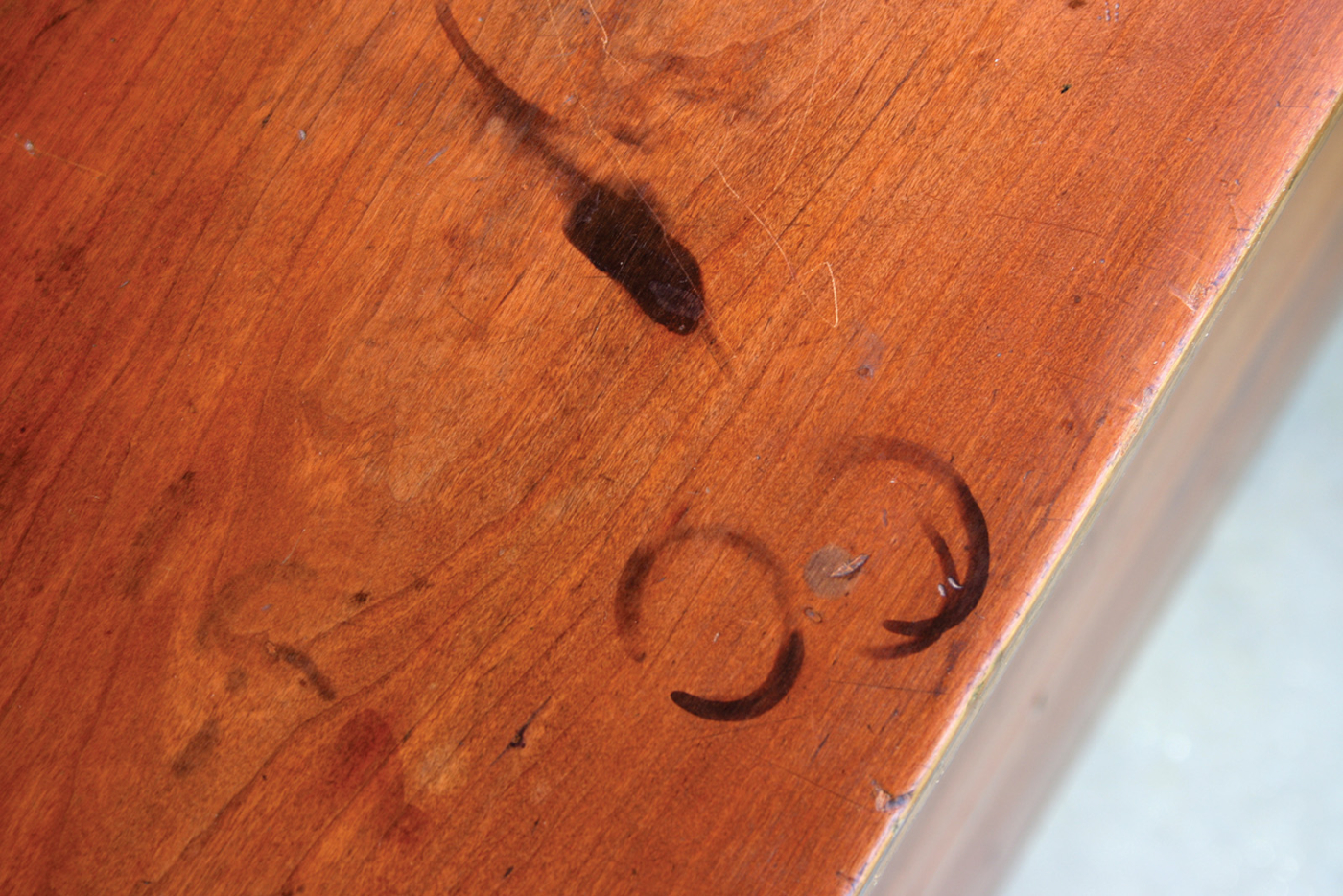
With this ring … The top of this dresser has small black rings that are an indication that someone set an ink bottle on it.
Desks and other surfaces where writing is commonly done have ink stains. Remember – when this furniture was new liquid ink came in a small bottle and writing was done by dipping a quill or a steel-pointed stylus. While writing and dipping, it is not hard to knock over the ink bottle.
Humidity in the air will cause rust and stain the wood surrounding iron fasteners, such as nails, screws and hardware. If a piece of painted furniture bumps or rubs against another, it will leave smears and streaks as some of the paint rubs off. As it’s moved, furniture bumps into painted woodwork and picks up paint smears that way.
When my son was a toddler he would sometime fling his bottle, spraying milk droplets. These landed on furniture and dried. Once dry I could not remove them, but was finally able to identify the spray of white spots I had observed on many antique pieces.

Flick it white. Any piece that has seen time in the garage or shop is almost certain to have paint splatters on it. Consider this as you plan your project’s fictional tale.
For centuries, people have been painting interior woodwork and walls every 20 years or so. Professional painters move the furniture in a room, or cover it with drop cloths, while homeowners are often less cautious. Paint drops, sprays of droplets, and even larger drips are found on antique furniture. People are even less careful when painting in a barn or garage. Any furniture stored there was spattered. Chair seats and small tabletops were used to hold a paint can, and often have drips and spills.
Lots of antique furniture has burns. Some of these were caused by the flames of candles and lamps. For example, a utilitarian iron candleholder called a hog scraper came equipped with a hook so it could be either hung up or placed on a flat surface. The top slat of a ladderback chair was a common place to hang a hog scraper, as from this location light was cast over the sitter’s shoulder. When the candle burned down to a nub, the flame came close to the wood. As a result, you will often find a narrow vertical burn on the rear of a ladderback’s top slat.
Clothes used to be ironed with a sad iron. This device was a block of cast iron in the traditional shape we know today. A sad iron was heated by placing it on the stovetop or placing it upright in front of the fireplace. The actual ironing was done on a tabletop. You know without being told that more than one person became distracted and set the iron down on the wood. As a result, lots of antique tabletops bear a distinctive, pointy ended burn.
For centuries smokers have placed lighted cigarettes and cigars on the edge of a tabletop when there was no ashtray handy. The distracted smoker forgets the lighted butt and voilà – a telltale narrow burn on the edge. Some smokers seem to have been pretty prone to this habit and to being distracted, because lots of tables have more than one such burn.
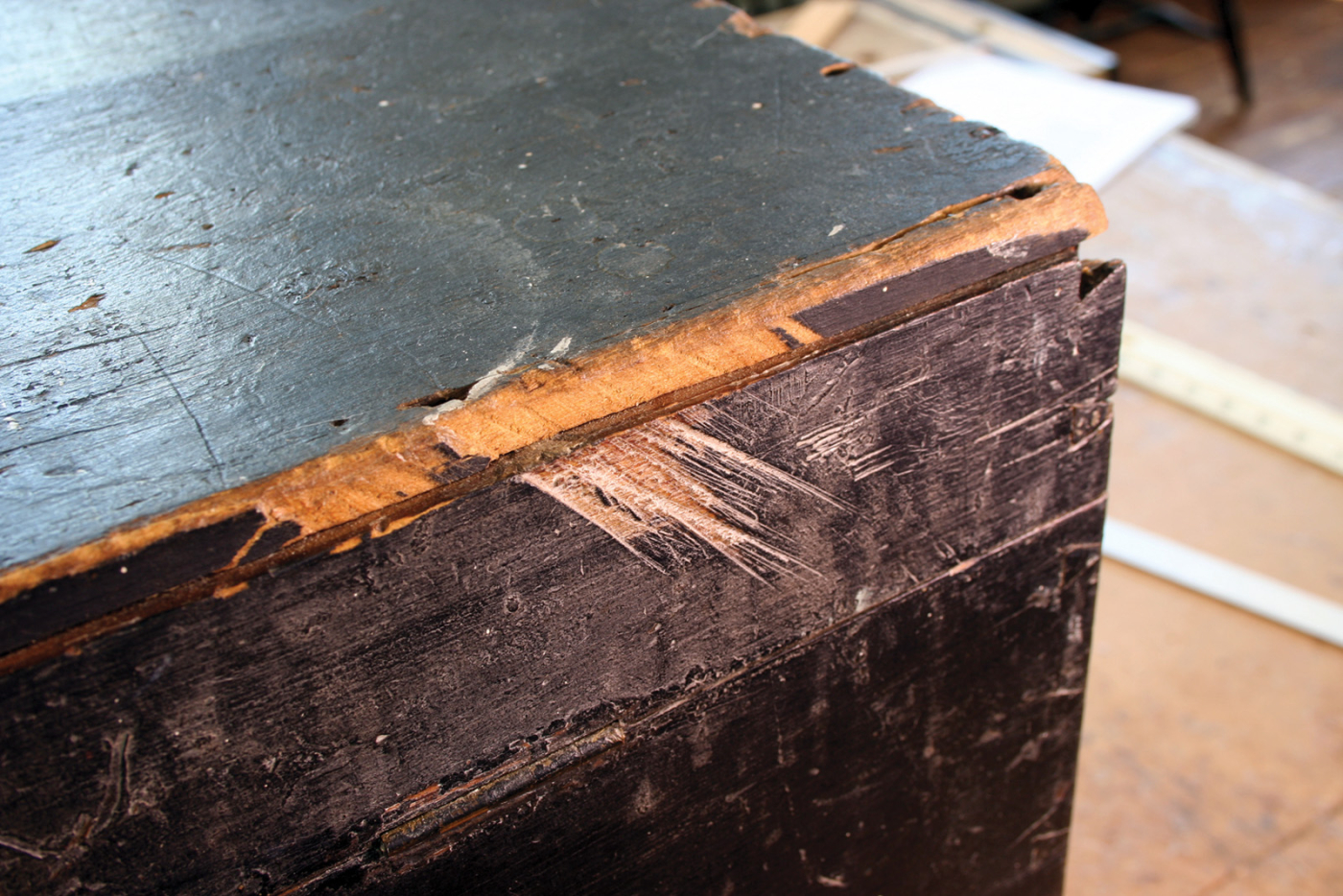
Scarred for life. Someone used this chest as a sawhorse, leaving a permanent mark on the lid and side.
Damage from Storage
When furniture was not being used (but was still too good to throw out) it was stored in an attic, cellar or an outbuilding, such as a garage or barn. Moving furniture to one of these places often causes scratches and dents where the piece is bumped against other objects such as doorways and stair rails. The same wear from moving furniture happens when antiques are bought or sold. It is so common it is known in the trade as “dealer damage.”
Long-term storage has other results. In the northeast, unheated attics become a freezer in the winter and an oven in the summer. Extremes in temperatures affect furniture adversely. In an attic, wood moves more than it does in a less extreme environment. In time, finishes – both paint and clear – begin to crawl and break up into a pattern like alligator skin. They also flake and loosen. In the antique world this chipped and dried-out look is called an “attic finish.” Many Windsor chairmakers are skilled at simulating an attic finish with milk paint.
The temperature in a cellar remains more stable, but being below ground, basements are humid – especially in the summer. The wood swells. The moisture attacks water-soluble animal glues, and joints loosen. Veneers lift off and inlay falls out. Finishes lose their bond. Sometimes finishes loosen so much that they can be brushed away like dirt.
Repairs: Good & Bad
Use causes damage, which necessitates repairs. Repairing furniture has been part of every woodworker’s daily routine from the beginning of the craft. We are still called upon to do the same work as the old guys. These are the nature of some of the repairs you may want to weave into the narrative as you are aging a piece of furniture.
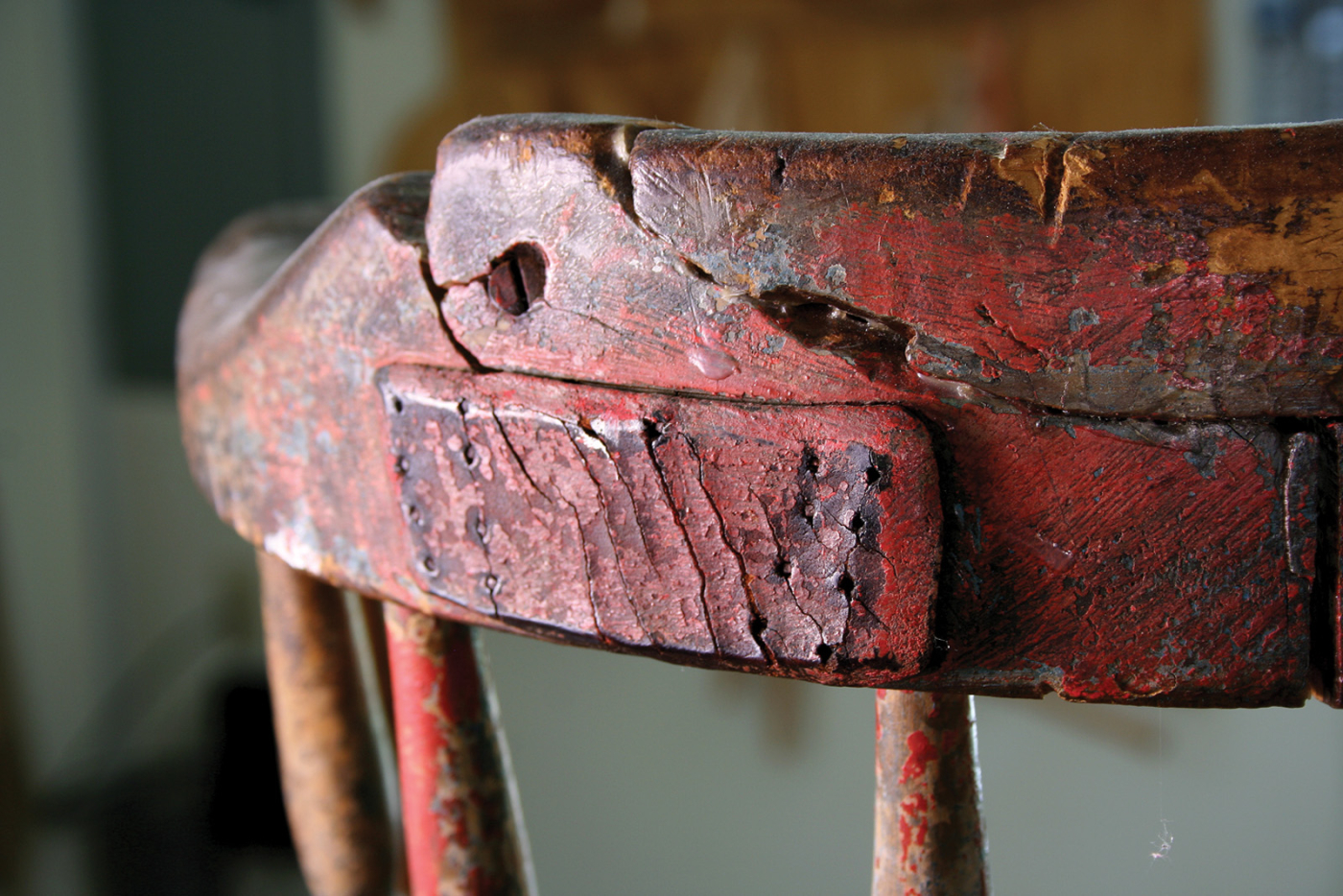
That fixed it. Repairs can be good, bad or just plain odd. Adding those to your pieces can be a special challenge.
Old furniture is sometimes converted and adapted to suit the owner’s current needs. While many of these changes devalue an antique, you can consider them when creating your fictional history. Conversions usually involve adding or removing something. Rockers are added to an old chair. A bed is cut down to fit in a room with a lower ceiling.
In conversions and repairs the quality of workmanship varies a lot. Often, the repairman was far less talented than the original maker, and his work will be much rougher. Sometimes a talented craftsman repaired a piece of furniture but added the flavor of his contemporary style. For example, a repair to a Queen Anne piece done around 1800 may have a more Sheraton feel.
The purpose of a repair or a conversion may be to update an old piece. For example, in the 19th century casters were often added to 18th-century table legs. A big part of every chairmaker’s business was to repaint old chairs. A Windsor made in the 18th century would have been a solid color, usually green. If repainted in 1820, the new finish would likely include striping and other decorative details, as found on the chairs made in that time.
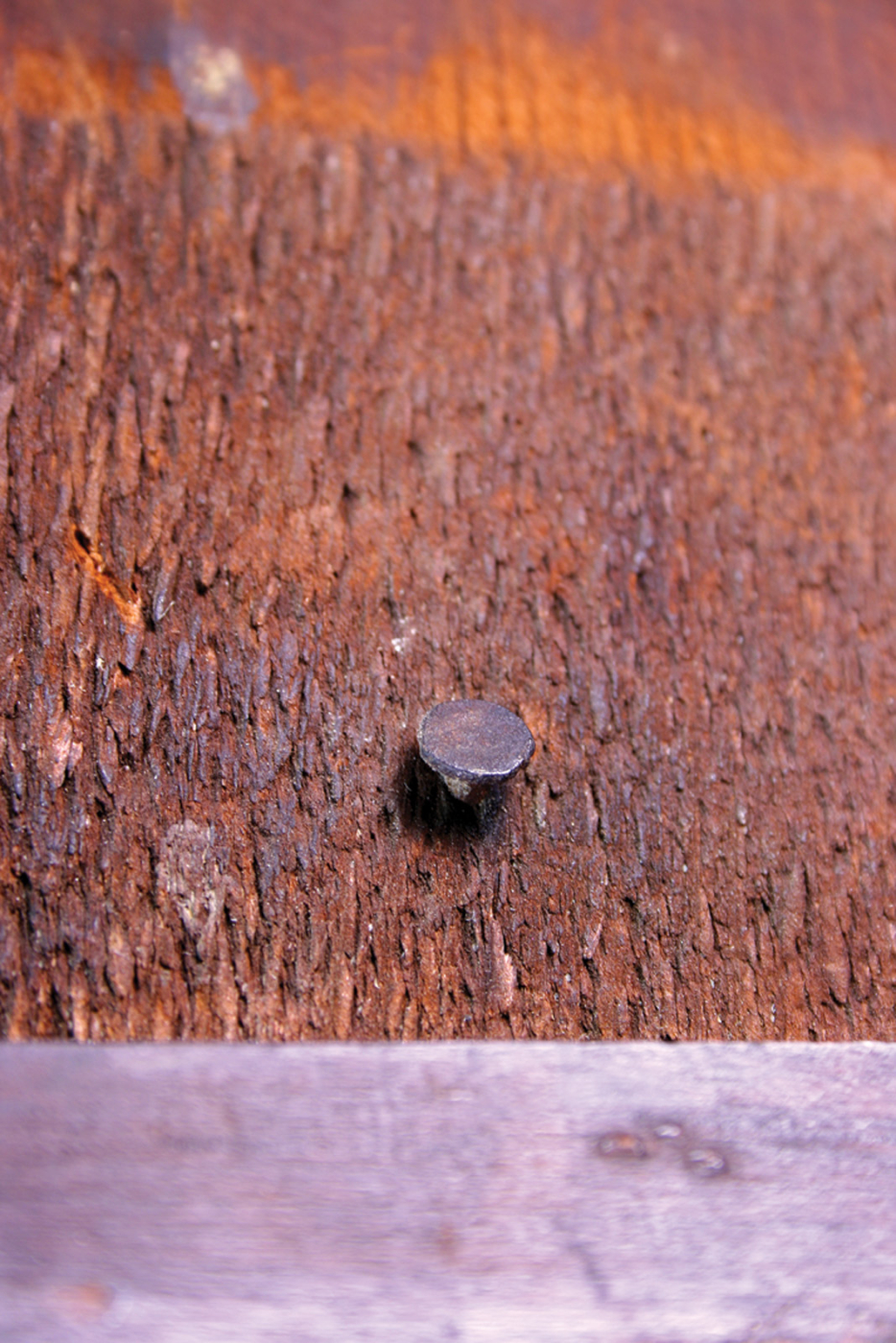
Wrong nail. Wire nails, which have a round shank and a round head, were invented in the 19th century and have no place on an early piece such as this – unless they were added to repair a piece.
Nail- and screw-making technology changed from the 18th century to the late 19th century. Repairmen did not hunt up old nails and screws to make repairs. They used what was available. Drawn wire nails and gimlet screws are often found in furniture originally made with wrought and cut nails and blunt-ended, hand-cut screws. A more recent repair might have been made with drywall screws and even square-drive screws.
Repair work often involves replacing missing or broken parts. Once again, workmanship varies a lot. Some repairs are so good they can be detected only by careful examination. Others scream. People sometimes live with furniture that has broken or missing parts, never bothering to fix or replace them. A customer might like such a detail as part of your fictional history. However, antique collectors will accept an old break, but not a new one. Freshly exposed wood will not likely fly.
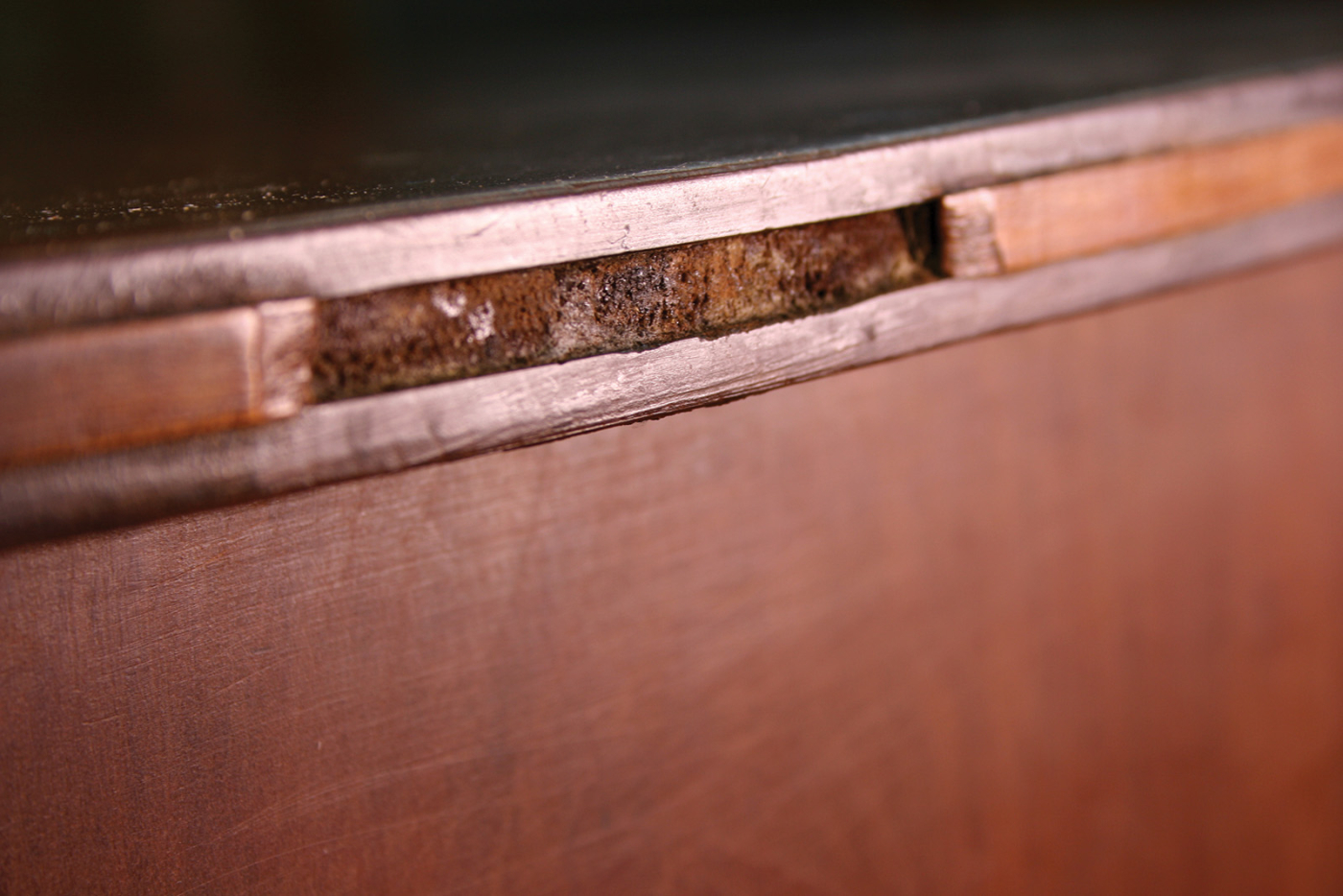
Missing tooth. The edge of this top is missing some of its inlay – a common form of damage seen on tops.
A piece of furniture with lots of veneer and inlay is unlikely to survive without chips or something missing. Veneer is very vulnerable on corners.
Some furniture includes materials other than wood. The writing surfaces of Federal secretaries and desks were commonly covered in green baize cloth. The originals are often faded, stained and even moth eaten. Cupboards and bookcases had glass doors made up of many small panes. Usually one or more is cracked. Don’t forget these details as you write your story.
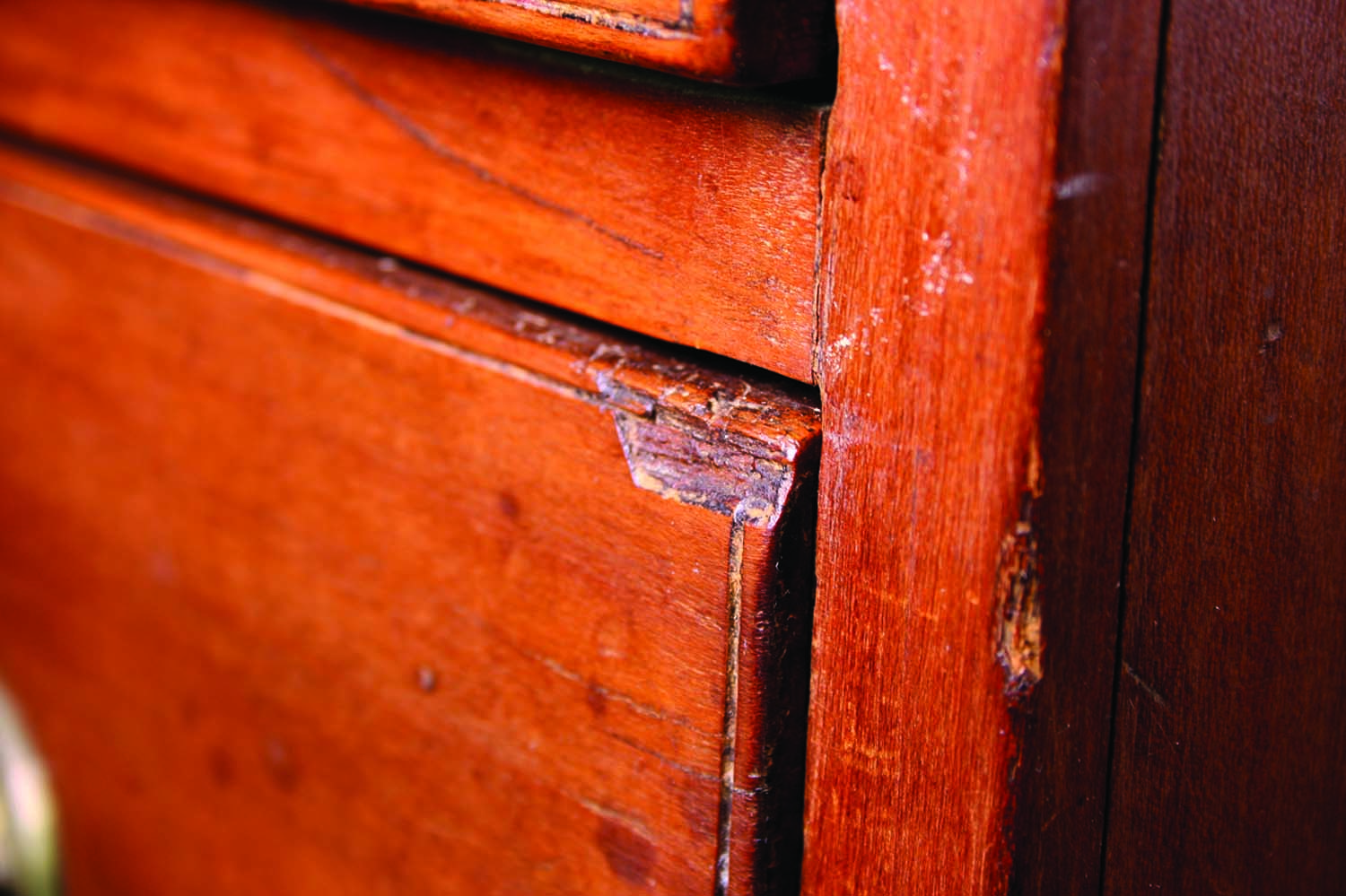
Busted. The corners of drawers are vulnerable, and it is common to see their edges chipped out like this.
The Stages of Wear
We have seen that except for a bump or a scratch, wear seldom happens all at once. It is cumulative and as a result, goes through stages. Regular rubbing or touching first creates a smooth polish in the finish. These places will be more reflective, and show up as highlights. In time, rubbing or touching will wear through a finish, exposing the wood below. Now, the wood begins to wear. Crisp edges and sharp corners will soften and become round.
The next stage in the process is like the effect of water wearing away rock. Many species (especially pine) have softer early wood and harder late wood. In other words, unlike plastic, many species of wood are not a single consistency. Softer areas will wear away, leaving the harder parts standing proud. Knots are hard and they wear much more slowly than surrounding wood. The result of slow wear on wood is a smooth but textured surface – a surface that tells your fictional history with the voice of the ages.
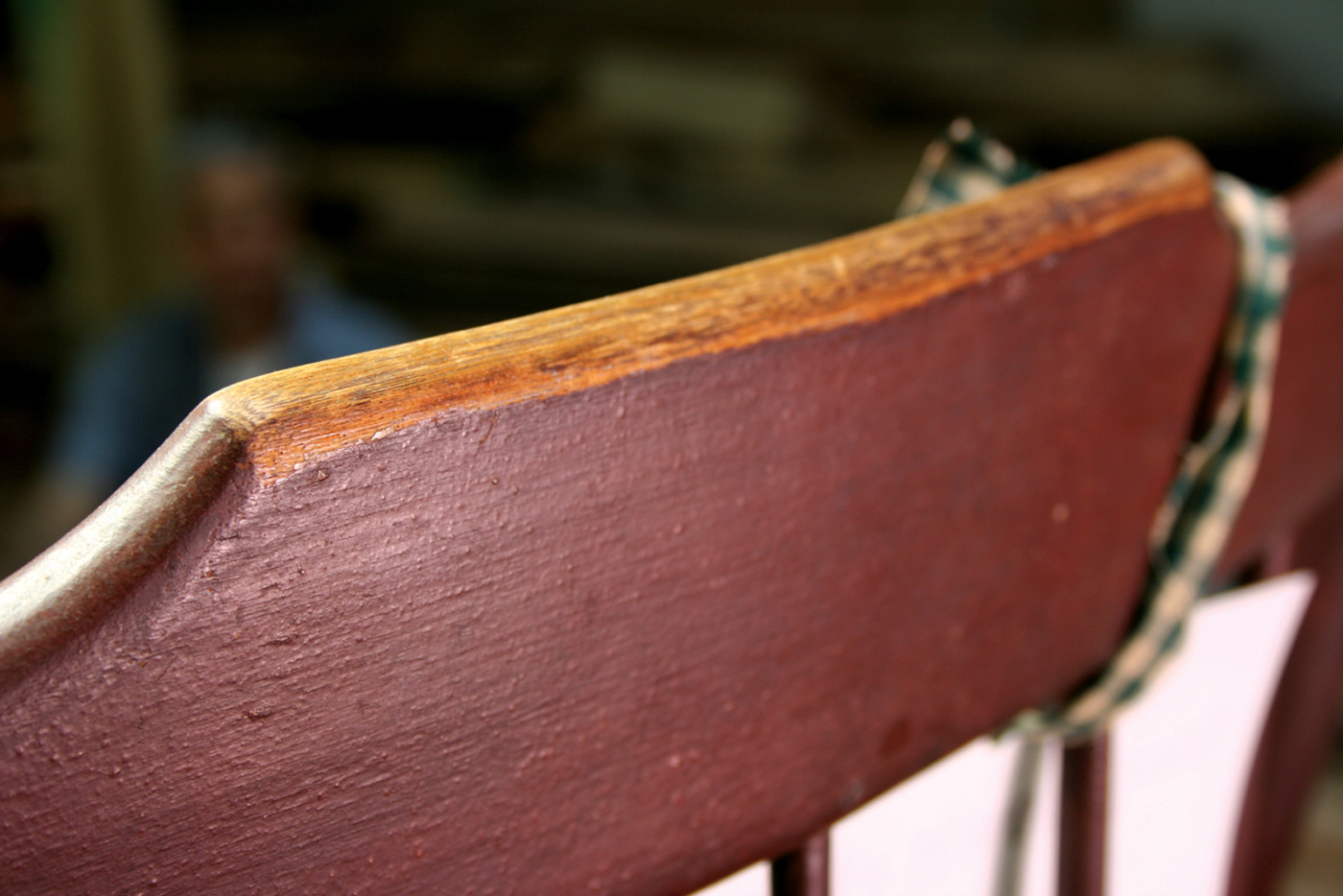
On purpose? The wear on this crest is almost a perfect straight line and looks like it was done on purpose, but it’s from the piece’s high, narrow shape.
Wood that is bumped repeatedly (as by cleaning instruments) wears differently. This is what happens over a long period of time. At first bumps bruise, crush and bend fibers. Additional bumps cause even more of this and eventually begin to loosen fibers. More bumping will break off these loose fibers, exposing those below. The exposed wood is not smooth, but rough. The rate at which this erosion happens also depends on the species. Very hard woods such as maple hold up better than softer woods.
Good luck creating your fictional histories. Remember, the life of a typical piece of furniture is a lot like ours. While all sorts of things happen to people, seldom does everything happen to one person. Tell a good story, but don’t get carried away. Keep it believable.
Here are some supplies and tools we find essential in our everyday work around the shop. We may receive a commission from sales referred by our links; however, we have carefully selected these products for their usefulness and quality.







